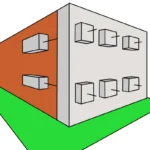What Is "Cement"?
Cement is a powdered substance composed not only of calcium oxide but also of silica, alumina, and iron oxide, giving it unique properties for various applications. By adding an appropriate amount of water to this mixture, a binding paste is created that can harden in both aquatic and open-air environments. It’s important to note that this definition excludes other materials like hydraulic limes, air limes, and gypsum, as each of them has distinct characteristics and behaviors related to solidification and specific applications. Cement, as a fundamental component in the construction and engineering industry, plays a crucial role in shaping and ensuring the durability of structures, providing a solid and reliable foundation for a wide range of projects.
Are Concrete, Cement, Mortar, and Concrete the Same?
In the field of engineering, especially Civil Engineering, it’s important to clarify the difference between concrete, cement, mortar, and concrete. Although these terms are often used interchangeably in everyday language, each of them represents different materials with specific applications and characteristics.
Cement is a fine binding powder obtained from the grinding of minerals such as clinker, silica, alumina, and iron oxide, among others. It is the primary component of concrete and mortar. There are various types of cement, such as Portland, Portland composite, Portland pozzolanic, and others, each with specific features suitable for different applications.
Concrete is a mixture of cement, aggregates (like sand and gravel), and water. When these materials are combined in specific proportions, they form a solid and sturdy mass widely used in construction of structures, from buildings and bridges to roads and pavements. Concrete is appreciated for its strength, durability, and versatility, making it one of the most commonly used construction materials worldwide.
On the other hand, concrete is a more general term that can refer to concrete itself or any similar material resulting from the combination of a binder (such as cement) with aggregates and water. The main difference between concrete and concrete is that the former is a specific type of concrete with a precise formulation, while the latter is a broader term encompassing various cementitious materials.
Mortar is a mixture similar to concrete but with a different ratio of cement, sand, and water. It is mainly used for bonding bricks, building blocks, and stones in masonry and finishing work. Mortar provides a strong and cohesive bond between materials, allowing the construction of stable walls and structures.
It’s worth noting that the terms “Reinforced Concrete” and “Reinforced Concrete” refer to the same mixtures but with the addition of reinforcing steel bars to enhance load-bearing capacity.
Portland Cement
Portland Cement is an essential and primary element in the construction industry, obtained through the pulverization of Portland clinker and enriched by the addition of one or more forms of calcium sulfate. It’s important to highlight that the inclusion of other materials in its composition is allowed, as long as they do not alter the qualities and characteristics of the resulting cement. Therefore, all these additional components must be ground together with the clinker to ensure the homogeneity of the mixture and the proper performance of the final product in the corresponding construction applications.
Types of Portland Cement
As the proportions of components vary during the manufacturing of Portland Cement, its performance can be modified. Therefore, different types of cement can be created to meet specific requirements and exhibit different physical and chemical properties.
Portland Cement Type 1: Ordinary
It is the most common variety of cement used in construction and is one of the most widely used types in the industry. It is known for its versatility and a wide range of applications, making it a popular choice for various construction projects. Since it is commonly used, it does not possess “special” properties like other types.
The main characteristics of Portland Cement Type 1 are:
- Compressive strength: Portland Cement Type 1 has high compressive strength, meaning it can withstand heavy loads and is suitable for applications in structures that require significant strength, such as buildings, bridges, dams, and other engineering works.
- Versatility: It is suitable for a wide range of applications, from residential construction projects to large-scale infrastructure, thanks to its overall performance and adequate strength.
- Setting and hardening time: Portland Cement Type 1 has a moderate initial and final setting time, allowing proper handling and placement of concrete during construction. This enables the concrete to achieve sufficient strength within a reasonable timeframe for various applications.
- Durability: When used and cured properly, concrete made with Portland Cement Type 1 can be durable and weather-resistant, providing a long service life for structures constructed with it.
Portland Cement Type 1 is used in various applications, including the construction of foundations, columns, slabs, beams, walls, pavements, and general structural elements. It is also used in the production of pre-mixed concrete and other precast concrete products.
Portland Cement Type 1-M: Modified
It is a slight variation of Type 1, but its characteristics are more pronounced. Consequently, it is slightly more expensive than the former. In many countries, this type is not present because any desired characteristics can be achieved by adjusting the mortar or concrete mix, as well as the use of reinforcement to enhance load-bearing capacity, rigidity, or flexibility.
Portland Cement Type 2: Moderate Sulfate Resistance
Portland Cement Type 2 is characterized by moderate resistance to sulfates, making it suitable for use in areas where the soil or water may contain certain amounts of sulfates. This includes regions near natural sulfate sources or areas with specific geological conditions.
This type of cement is used in applications where moderate sulfate resistance is required but not as high as that provided by other types of cement, such as Type 5, which is more resistant to sulfate attack. Portland Cement Type 2 can also be used in general construction applications as long as conditions are not too aggressive in terms of sulfate presence.
Portland Cement Type 3: Rapid Setting
Portland Cement Type 3 is a special type of cement used in the construction industry known for its high early strength. It is also referred to as “rapid-setting cement” or “high early strength cement.” It is one of several Portland Cement types, each designed to meet specific requirements based on the type of construction project.
The main features of Portland Cement Type 3 are:
- High early strength: This type of cement develops significantly faster strength than other common types of cement. This means that concrete made with Type 3 cement gains substantial strength in the early stages of curing, allowing for early formwork removal and accelerated construction schedules.
- Accelerated setting: Portland Cement Type 3 has a shorter setting time than other cement types, which means it begins to harden more quickly after being mixed with water. This makes it suitable for situations where rapid strength development and early service are needed.
- Use in cold or low-temperature climates: Due to its high early strength, Type 3 cement is suitable for projects in cold climates or low-temperature conditions, where other types of cement may struggle to achieve adequate strength during curing.
Portland Cement Type 3 is used in various applications, such as rapid road repair projects, high-traffic road paving, precast construction, and wherever fast setting and early strength are needed to expedite construction.
Portland Cement Type 4: Low Heat of Hydration
Portland Cement Type 4 is not a common type of cement found in most construction specifications. In fact, in many regions and countries, the most common types of cement are Type I, Type II, Type III, and Type V, each with specific properties and uses.
Portland Cement Type 4, although not widely used, is known as “Low Heat of Hydration Cement.” Its primary characteristic is that it generates less heat during the hydration process compared to other types of cement. This can be advantageous in certain situations, especially in large concrete masses, where excessive heat of hydration could lead to cracking or durability issues.
Generally, Type 4 cement is used in massive construction projects, such as dams, underground structures, or large concrete structures that may be more exposed to the risk of cracking due to heat of hydration.
Portland Cement Type 5: High Sulfate Resistance
Portland Cement Type 5 is primarily known for its resistance to sulfates. Sulfates are chemical compounds found in certain soils and groundwater, and they can attack and weaken concrete structures if not properly managed. This type of cement is suitable for use in areas with higher exposure to aggressive sulfate-containing soils or waters.
When building structures near marine waters or in areas where the soil contains a significant amount of aggressive sulfates, Portland Cement Type 5 is preferred. Its chemical composition is designed to resist the harmful effects of sulfates and maintain the integrity of the structure over time.
Portland Cement with Air-Entraining Admixtures: With Additives
Portland Cement with air-entraining admixtures is a special type of cement that contains chemical additives known as air-entraining admixtures. These additives are designed to introduce small air bubbles into the concrete mix during the mixing process. These air bubbles are distributed evenly in the concrete and act as internal stress reducers when the concrete undergoes volume changes, such as those caused by temperature fluctuations.
The use of air-entraining agents in Portland Cement offers several benefits and applications:
- Freeze-thaw resistance: The air trapped in the concrete reduces internal pressure that forms when water in the concrete freezes and expands. This helps prevent damage and surface cracking during freeze-thaw cycles.
- Improved sulfate resistance: Like Portland Cement Type V, air-entrained concrete can enhance sulfate resistance in areas where soils or waters contain aggressive sulfates.
- Increased durability: By reducing internal stress in the concrete, its overall durability is improved, minimizing the possibility of cracking and long-term damage.
- Enhanced abrasion resistance: Air-entrained concrete can also improve its resistance to abrasion and wear, making it suitable for pavements and surfaces subjected to high traffic.
Air-entrained concrete is used in various applications, such as road pavements, airport runways, sidewalks, industrial floors, and structures exposed to aggressive environments. It is especially useful in cold climates or projects where resistance to freeze-thaw cycles is essential. To distinguish them, an “A” is added, for example, Portland Cement Type I-A or Type III-A, etc.
White Portland Cement:
White Portland Cement is a special type of cement that differs from ordinary Portland (gray) cement due to its distinctive white color. It meets the specifications of Portland Cement Type 1 (NTC 1362). It is produced using selected raw materials with low amounts of iron and manganese oxides, resulting in a lighter final product.
The white color of White Portland Cement is highly valued in applications where a cleaner and brighter aesthetic appearance is desired. Some common applications of White Portland Cement include:
- Architectural applications: It is used in the manufacture of architectural elements such as decorative panels, moldings, statues, stairs, and cladding, where white color enhances design and aesthetics.
- Production of tiles and ceramics: White cement is used in the manufacture of tiles, ceramics, and other ceramic products, as it allows for brighter and more uniform colors on the surface.
- Restoration of historic monuments: Due to its light color and ability to provide a more consistent appearance, white cement is used in the restoration of monuments and historical structures where preserving the original look is essential.
- Finishes and stucco: It is used in the manufacture of finishes and stucco to achieve white or lightly tinted surfaces.
It is essential to note that White Portland Cement has mechanical properties similar to Gray Portland Cement but may have slightly lower strength due to variations in chemical composition. Therefore, it is crucial to follow the manufacturer’s recommendations and appropriate specifications for each specific application.
Compression Strength
Due to differences in their components, it is well known that each type of cement will have different setting times and will reach its maximum compressive strength at different times. It is estimated that the maximum compressive strength is achieved at 28 days, but in the case of using any cement other than Type 1, this time may extend up to 90 days.

Chemical Composition
Here is a general representation of the composition of Portland Cement Type 1, the most common in construction; the percentages may vary depending on the factory.

Manufacturing
The cement manufacturing process involves several steps. Firstly, raw materials are finely ground, and they are meticulously mixed in a specific proportion. Next, they are calcined in a large rotary kiln at a temperature of around 1300 to 1400 °C. At this high temperature, the raw materials partially synthesize and melt, forming clinker balls. The clinker is then cooled, and a small amount of gypsum is added, and more recently, pozzolanic material. This mixture is crushed into fine powder, resulting in the commercial product known as Portland Cement.
The process of mixing and crushing the raw materials can be done in both wet and dry conditions, giving rise to the manufacturing methods called “wet” and “dry.” The choice of method depends on the nature of the raw materials used and, to a large extent, on economic factors.
Commercially, the two methods mentioned above (wet and dry) are the most widely used for cement production. However, other methods are used in small-scale manufacturing, such as the semi-dry method, vertical kiln manufacturing, and preparation grate kiln manufacturing (Lepol). These alternative methods allow for adapting cement production to different needs and specific conditions.
About The Author
Samuel Parariá
Estudio: University of Francisco de Paula Santander.
Major: Civil Engineering.
Favorite Areas: Structures, Traffic Engineering, and Road Design.
Location: Cúcuta, Norte de Santander, Colombia.







Related
Pavers in Civil Engineering
What are the Non-Mechanical Properties of Materials in Civil Engineering?
Mechanical Properties of Materials (under construction)